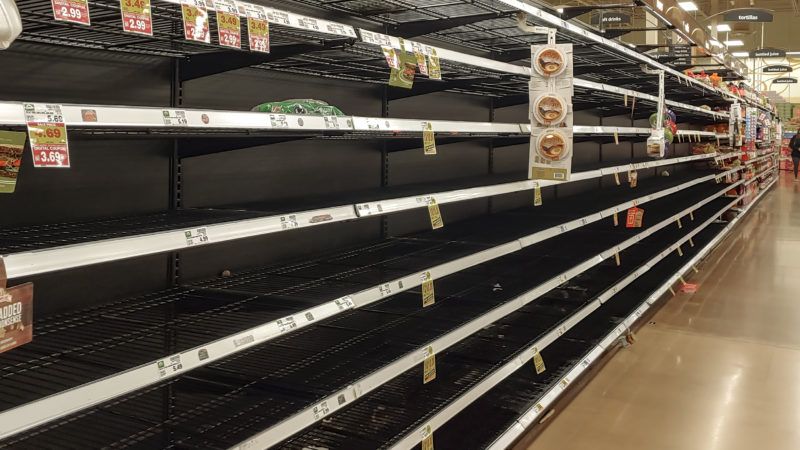Federal Regulations Are Making the Grocery Store Supply Crunch Worse
The FDA has relaxed some labeling laws in order to allow restaurants to sell groceries, but it could do more.

Seeing empty shelves at your grocery store might come as a shock even in the middle of a pandemic—sometimes capitalism looks like how socialism looks all the time—but the problem isn't a shortage of food. It's that supply chains are struggling to adapt to changing circumstances.
Prior to the COVID-19 pandemic, about half of all American food expenditures (and about 15 percent of consumption) were at restaurants and other commercial dining establishments. Those numbers have shifted dramatically in recent weeks, and "a distribution system that was built to supply restaurants with bulk items is struggling to adapt to far smaller packaging for home use," The Washington Post reported last week.
One complication in reconfiguring those supply chains on the fly to direct more food to grocery stores and less to restaurants: federal regulations.
"Many of the ingredients, processes and regulatory requirements for manufacturing food products destined for grocery stores and restaurants are virtually identical," says Betsy Booren, senior vice president for regulatory and technical affairs with the Consumer Brands Association, an industry group that represents grocery stores and food producers. "What does most often differ is the packaging and labeling of food destined for restaurants versus grocery stores."
Think about a package of hamburger buns. The one you might buy in a grocery store contains the exact same buns that a producer might also send to a restaurant down the street. But there are two key differences in packaging. First, the restaurant isn't buying them in packages of eight or 12 at a time. Second, while the restaurant does have to comply with Food and Drug Administration (FDA) requirements for publishing nutritional information on menus, the buns they are buying don't come with as many specific labels and data on the package.
In March, the FDA waived some of its labeling requirements to allow restaurants to sell their unused food directly to the public. Repackaged, unprepared food from restaurants must contain a description of the product and the FDA's mandatory warnings about potential allergies, but more detailed information—like the "nutritional facts" found on anything you might purchase in a grocery store—can be skipped.
(Of course, even federal regulatory approval has not been enough to prevent some insane local officials in places like Boston and Los Angeles from banning restaurants from acting as impromptu grocery stores.)
"It's not terribly unreasonable to have these sort of minimal safety rules remain in place," says Gregory Conko, a senior fellow with the Competitive Enterprise Institute, a free market think tank. "But from a regulatory perspective, it would be great if that rule could apply beyond restaurants so you could ship that same product to a grocery store."
With the food service industry facing a 60 percent decline in sales due to the COVID-19 outbreak, those labeling requirements have complicated efforts to reroute food from restaurant supply chains to grocery stores.
"Companies are looking for opportunities to divert this food to other supply streams, including grocery stores," says Booren.
Easing those restrictions won't fix all the problems, but it would help. Grocery stores may be unable to accept foods packaged and labeled in certain ways because there is simply no demand from consumers to purchase large bulk containers of certain items, or because it is not cost-effective for grocery stores to break down the bulk food and repackage it into smaller portions for sale, Booren says.
That's one of the reasons why the dairy supply chain has been particularly hard hit. Stories of milk trucks dumping their goods, for example, are likely the result of too much supply and not enough demand. Restaurants consume far more milk and butter than most consumers do, and those products spoil quickly.
Some states have stepped up to the task. Wyoming, for example, passed a new law that allows ranchers to sell cuts of meat directly to consumers. Anything that can be done to ease food supply chain bottlenecks should be considered right now.
Conko says the current mess should put the spotlight on some regulatory issues that have been ignored for years, including some seemingly inexplicable regulatory overlap between the FDA and U.S. Department of Agriculture (USDA)—like the fact that frozen pizzas are subject to FDA regulation unless they have a meat topping, in which case they fall under USDA jurisdiction. Or the fact that an egg-laying chicken is regulated by the USDA, but the egg the chicken lays is regulated by the FDA until it is cracked open and used as an ingredient in another product, at which point the USDA takes over again.
With so many unnecessary or questionable regulations being suspended or abolished during the coronavirus outbreak, Conko sees an opportunity to streamline food supply chains too.
"We really ought to rethink the way we do this across the board," Conko says. "Does this now all of a sudden add weight to those arguments? Maybe a little, but I think they were pretty strong to begin with."


Show Comments (15)